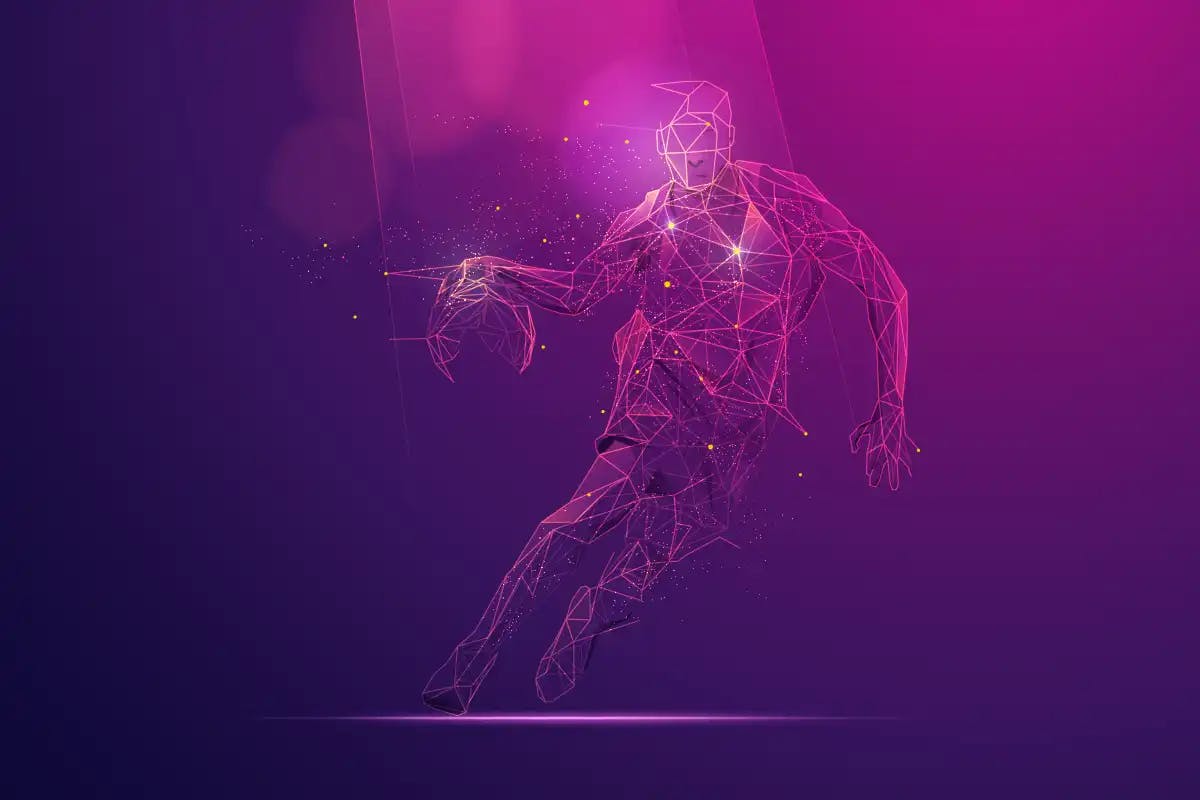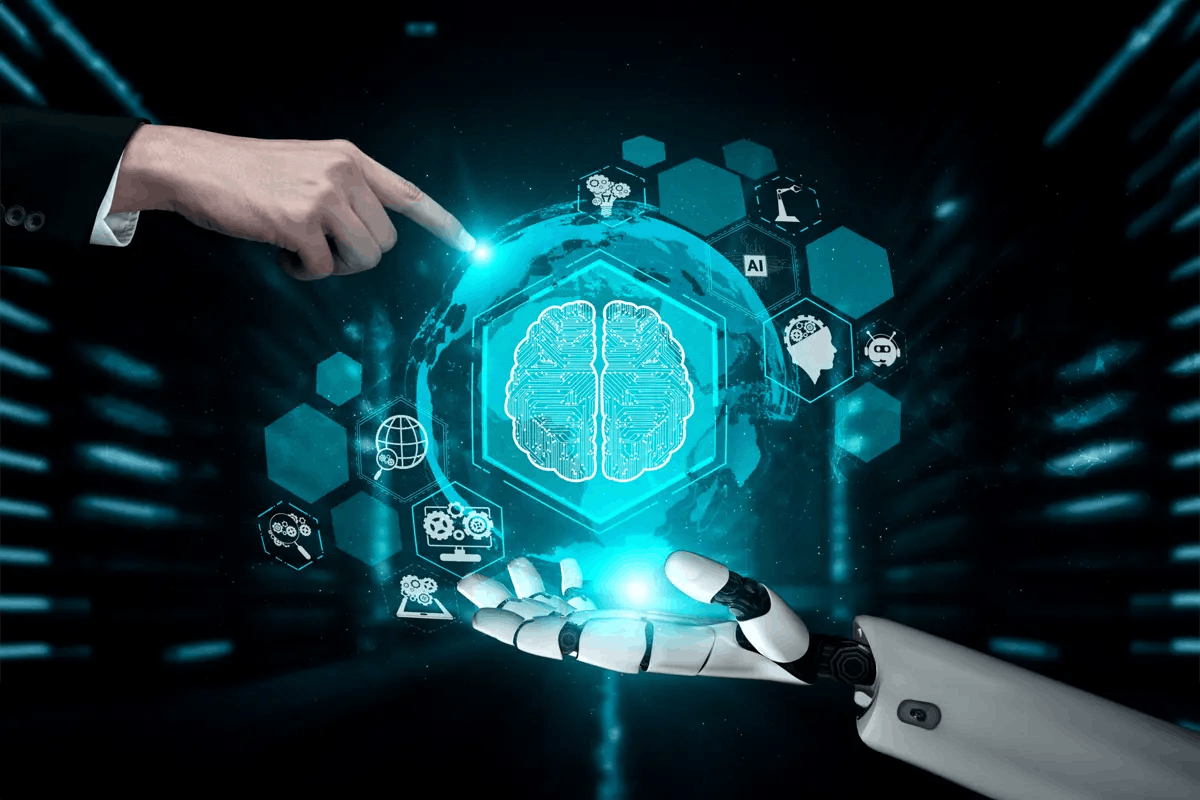
,
Machine Learning is like teaching a computer to make decisions and predictions all on its own, without someone having to guide it through every single step. It's about giving computers the ability to learn from data and get better over time, kind of like how we learn from experience. This is super important in the world of AI because it's the foundation for creating systems that can adapt and respond smartly to all sorts of situations. Now, the role of ML in AI is pretty big.
Globally, the market for artificial intelligence (AI) was valued at approximately 119.78 billion US dollars in 2022 and is forecasted to reach around 1,597.1 billion US dollars by 2030. Within this market, the AI sector in North America was valued at roughly 147.58 billion US dollars as of 2021.
It starts with making sense of data. Imagine tons of raw data coming in – ML helps in turning this data into something meaningful. It's all about finding patterns and connections in the data that the AI system can learn from. This is how AI gets to be smart and make decisions that feel almost human-like. Understanding Machine Learning is key if you're diving into AI. There are different techniques, and each has its special use.
For example, regression is all about predicting things like prices or temperatures, while classification is about sorting things into different categories. Then you've got clustering, where you find groups in data without any labels, and the more complex stuff like neural networks and deep learning – these are the big guns for tackling really complicated tasks. So, let's get started and explore these game-changing techniques that are making AI systems smarter by the day!
Regression
Let's talk about one of its key tools: regression analysis. This is a major player when it comes to AI and predictive modeling. Think of regression as the go-to method for figuring out how different things are connected and what's likely to happen next. It's like having a crystal ball for trends, from predicting stock market moves to guessing how much energy we're going to use.
At its heart, regression is all about spotting and measuring the links between things. Take linear regression, for example – it's super straightforward and perfect for times when one thing affects another in a pretty straight-line kind of way. But let's face it, life's usually a bit more complicated than that. That's where non-linear regression steps in, bending and twisting to fit those trickier, curvier trends. Why is regression a big deal in AI? Well, it gives us a way to make smart guesses about the future based on past data. These regression models chew over old data to predict stuff that's super important for businesses, scientific research, and tech innovations.
In the AI world, regression models are everywhere. They're behind the scenes in finance, predicting stock prices, and in marketing, forecasting how many products we'll sell. In the world of healthcare, this is where regression shows its magic. It's like having a health detective that can predict trends and patient outcomes. The trick is to spot patterns and connections in the data. This is super important for AI in healthcare, it needs to be spot-on with its predictions. Think of it like a doctor who can look at a patient's history and say, "Based on what's happened before, here's what might happen next". That's the kind of insight regression brings to AI in healthcare, helping it make smart, informed guesses about future health trends and how patients might fare. It's all about connecting the dots in the data to stay one step ahead.
In short, regression in ML is a big deal, it's not just about drawing lines through data points; it's about getting the full picture and making smart moves based on that.
Classification
In the world of Machine Learning, classification is a real game-changer, especially for AI projects that lean on supervised learning. Here's the deal: classification sorts data into specific groups. Think of it as the secret sauce for jobs that need clear-cut answers, like figuring out if an email is spam or what's going on in a medical test.
Here’s how it works. Classification algorithms start by getting cozy with labeled data. This is where supervised learning struts its stuff. The algorithm trains on a dataset where every data point is tagged with the right answer. It’s like a learning phase where the algorithm picks up how to match features in the data with these labels. Once it’s got this down, it’s ready to take on new data and classify it like a pro.
Take decision trees, for example. They’re like the friendly neighborhood guides in Machine Learning. Easy to get and super practical. They chop up complex data into smaller bits, creating a map of decisions as they go. The result? A clear tree that shows you how decisions lead to different classifications.
But the toolbox doesn't stop there. There’s a whole lineup of techniques like logistic regression, k-nearest neighbors, support vector machines, and neural networks, each tailored for specific kinds of classification challenges.
What’s cool is how versatile these methods are. They’re the behind-the-scenes heroes in everything from marketing (like figuring out customer groups) to banking (catching fraudsters), and from tech (like understanding what you say to your phone) to sorting out what’s in a picture.
So, Classification in Machine Learning isn’t just a fancy trick. It’s a critical piece of the puzzle in building AI that’s smart enough to sort through data and make sense of it, leading to systems that not only make smart guesses but also informed decisions.
Clustering
In the world of Machine Learning, clustering is like a detective uncovering hidden stories in data. It's part of the unsupervised learning crew, which means it doesn't need any pre-labeled data to get cracking. Clustering is all about finding secret patterns and neat groupings in data, making it super handy for AI tasks where you need to figure out the natural structure of your data and break it into meaningful chunks.
So, how does clustering work its magic? Unlike its cousin, supervised learning, where everything's labeled and organized, clustering algorithms sift through data, looking for natural groupings based on how similar or different the pieces of data are. It's like sorting a mix of fruit into neat baskets of apples, oranges, and bananas without someone telling you which is which.
Take K-Means clustering, a real crowd-pleaser in Machine Learning. This guy is all about diving your data into K clear groups (or clusters). It shuffles data points around until they're huddled around the center of their group, minimizing the distance between them. K-Means is loved for its simplicity and speed, making it a go-to for quick clustering tasks.
But the clustering world is bigger than just K-Means. You've got other options like hierarchical clustering, which builds a tree of data points, and DBSCAN, great for dealing with odd-shaped clusters or outliers. Each one shines in different scenarios, so picking the right one is all about what your data looks like and what you need from it.
Neural Networks & Deep Learning
Neural Networks and Deep Learning are creating some serious waves in AI. Picture these as the brainy heavyweights in Machine Learning. They're cleverly mimicking how our brains work, using artificial neurons to crunch through heaps of data in ways traditional methods just can't.
The magic of Neural Networks lies in their layout – layers upon layers of nodes (sort of like mini-brains), each layer tweaking the incoming data based on its learning. This multi-layered approach lets them pick up on complex patterns, making them champs at recognizing images or understanding speech.
Deep Learning takes this up a notch. Imagine Neural Networks with extra layers – that's Deep Learning for you. These layers allow the network to dissect and understand data in much finer detail. That's why they're the driving force behind some of the coolest AI out there – think self-driving cars and real-time language translation apps.
Neural Networks are everywhere in AI. In healthcare, they're like high-tech doctors, diagnosing diseases from scans. In the world of finance, they're the savvy analysts, predicting market moves. And in retail, they're the personal shoppers, suggesting products you might like.
With the ability to process a wider variety of data and recognize more intricate patterns, it’s taking accuracy to new heights. It's this constant learning and adapting that's key to the future of AI.
Dimensionality Reduction
In the world of AI and Machine Learning (ML), there's a super handy trick called dimensionality reduction. It's like having a magic wand that simplifies complex data while keeping all the good stuff intact. This technique is a lifesaver, especially when dealing with big, complicated datasets.
Think of dimensionality reduction as a way to slim down the data. The aim is to shrink the number of input variables but still hold onto the key characteristics of the data. It's like packing for a trip – you want to take just what you need without lugging around a heavy suitcase. This not only makes life easier for your computer but can also boost the performance of your ML models.
One of the go-to methods in this space is Principal Component Analysis (PCA). PCA is like a data detective. It takes your original data and reworks it into new, uncorrelated variables called principal components. These components are super smart – they're arranged so that the first few capture most of the action from your original data. By focusing on these top components, PCA cuts down the data's dimensionality while holding onto the important bits.
Dimensionality reduction shines in areas like image processing, where you often have a ton of data to work with. It helps in breaking down these massive datasets into something more manageable, paving the way for more advanced ML models to do their thing effectively.
Then there's feature extraction, a close cousin of dimensionality reduction. This involves tweaking and combining existing features to create new ones that pack the same informational punch but in a more compact form. It's especially useful when you've got too many features or they're too tangled up to be helpful.
Dimensionality reduction is a game-changer in ML and AI. It's all about making data easier to handle and analyze, keeping the computational load in check, and ensuring the insights you get are spot on. Whether it's through PCA or other nifty techniques, being able to boil down huge datasets to their essence is key to building effective and efficient AI systems.
Wrapping It Up
Getting the hang of ML techniques like regression, classification, clustering, and all that jazz isn't just for tech whizzes. It's super important for anyone diving into AI. These methods are like the building blocks of today's AI. They help us sift through all the complicated data and find those golden nuggets of insight. Staying on top of these techniques? Essential. They're like the secret sauce that makes AI projects go from good to great, boosting efficiency and productivity.
Transform your business with Codiste, a top AI development company in USA. Our cutting-edge AI solutions, tailored to your unique needs, drive innovation and efficiency. Partner with Codiste for unparalleled expertise in AI strategy, development, and implementation. Elevate your business today with Codiste's AI excellence.



How AI-Powered Video Editing Tools Are Revolutionizing Video Translation and Localization
Know more
Top Vulnerabilities in MCP Servers & How FinTechs Can Protect Themselves
Know more
